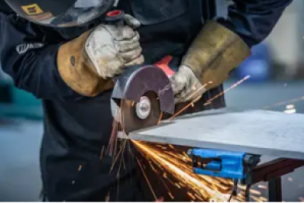Nickel is extremely important for manufacturing. Learn how to better cut this challenging metal—and how to use neat oil to help cool it down.
What You Need to Know
Nickel and its alloy cousins are tough to cut, but nickel’s corrosion resistance and strength make it ideal for so many applications, including in aerospace and other key manufacturing industries. Get clear, concise advice on how to work with this vital material—and how to get the most out of your cutting tools.
As number 28 on the periodic table, nickel was first isolated in 1751. Its name comes from the belief by German miners that the reddish-brown metal, known then as “kupfernickel” (which translates to “devil’s copper”) was making them sick. In reality, their illness was caused by the high amount of arsenic contained in the ore they were removing from the cobalt mines of Sweden.
Nickel is an extremely important metal. Along with chromium, it is one of the most essential of all alloying elements, used in a wide variety of steels, stainless steels and superalloys. It’s tough, corrosion-resistant and exhibits excellent strength and impact properties. Common types of nickel-alloys include Inconel, Hastelloy, Waspaloy, stainless steels including 304, 316 and 17-4—and others. Given a sharp tool and the right cutting parameters, pure nickel is not terribly difficult to turn or mill, although nickel alloys such as Ni-Span-C 902 and Monel K-500 bear machinability ratings of 15 percent or less. Here are a few things you should know if you’re currently working with, or about to work with, this challenging material.
1. Keep Your Metal Cutting Tools for Nickel Alloys Coated and Sharp
Nickel and its various alloys tend to work harden during machining. There are several ways to combat this. First, the cutting tool should have a positive rake and sharp edge. Because it is less brittle than carbide, high-speed steel might work well, although the cutting speeds in this case must be kept quite low, typically at 100 surface feet per minute or less as a starting point.
Depending on the alloy, a tough, premium grade PVD-coated carbide will generally provide the best tool life and productivity, although some cutting tool suppliers suggest ceramic or cermet as an alternative—be open to their recommendations. CBN may be used on hardened 17-4 PH and similar heat-treated alloys. Use a round insert or one with a positive lead angle wherever possible to minimize notching. Variable helix and variable flute end mills help to break up the harmonics that lead to chatter. If using HSS, drills should have a sharp chisel edge and a split, 135-degree point. Keep tools sharp and replace them sooner rather than later before disaster strikes.
2. Stay Rigid in Your Nickel Alloy Cutting
Making setups as rigid as possible is good advice for any machining application, but especially so for super-tough metals like nickel and nickel-bearing alloys. For milling operations, a shrink-fit holder is often the first choice, with hydraulic or mechanical milling chucks coming in a close second. Leave the sidelock holders in the tool crib. Similarly, hydraulic work holding should be used whenever possible, even if it means investing in new vises and chucks. Overhangs must be kept to a minimum to avoid tool deflection and the chatter that comes with it. This might be a good time to investigate vibration-dampening boring tools, and if your machine tool is so equipped, be sure to understand and engage its anti-chatter functions.
Want to learn more about high-temperature metals used in aviation industries? Read “4 Aerospace Materials That Are Taking Off.”
3. To Aid Tool Life, Get Aggressive with Feeds and Speeds
Having trouble with tool life? Your first instinct might be to ease off on the feed and slow down the spindle. Bad idea. All cutting tool manufacturers supply recommended surface speeds, depths of cut and feed rate ranges. When trouble strikes, it’s often a good idea to shoot for the upper end of those parameters and cut more aggressively, not less. Doing so, however, first depends on the points just mentioned—a rigid setup—as well as using the correct grade of cutting tool. Above all, learn to identify failure modes—notching at the depth of cut line and built-up edge (BUE) are common with nickel-based materials, both of which lead to catastrophic tool failure if not addressed in a timely manner.
4. Take the Right Toolpath
Proper programming strategies are paramount. Trochoidal toolpaths provide consistent chip loads and prevent shock to the cutting tool and workpiece alike. Because nickel-based alloys are tough, stepovers should be well below the radius of the milling tool and feed rates relatively high. Conversely, the minimum depth of cut for turning should be no less than the tool nose radius, and preferably several times that if possible. High feed milling techniques using button-style and comparable cutting tool geometries drive forces upward into the spindle, minimizing deflection. Ramping into and out of the cut is effective on both CNC lathes and machining centers. Avoid dwelling in corners.
5. Find the ‘Goldilocks’ Zone: Document Your Parameters and Cutting Conditions
Finding the sweet spot for machining alloys high in nickel requires some trial and error. You can avoid unexpected failures by developing a predictable, tested process, but this in turn calls for documenting what tools, grades, coatings and cutting parameters have been tried, and the results for each. Take baby steps. Don’t be afraid to push beyond the manufacturer’s recommendations, but be sure the process is stable before walking away from the machine. If you have it, use your machine tool or tool crib’s tool life management function to monitor how long a tool has been in the cut—if not, document tool life the old-fashioned way, using pen and paper. If you can get 15 minutes out of an insert, count yourself fortunate. Nickel machining is no time for tribal knowledge, second-shift secrets, or uncontrolled process changes. Get documenting.
What kinds of issues or problems have you encountered when cutting nickel or its alloys? Share your experience.




Talk to Us!
I have been cutting exotics and high nickel alloys for several decades and have documented the sweet spot for long tool life and high production rates for each. Over the years I have found that the Machinery Handbook is pretty much spot on for the sweet spot. Trust your handbook even though the recommended speeds and feeds seem to be a little hot. Great article, thanks
39Great tip George, thanks for sharing. If you have any other tips of trade experts, we'd welcome you to share in our Forum at https://www.mscdirect.com/betterMRO/forum
34Hi,I am going to be turning hollow bar Dia 160MM x 140MM and is 1300mm long.The material is just decribed as Nickle.What speeds and feeds are recommended for roughing and then finishing.I have basically N7 finish all round.Thanks in advance.Cheers Derek
58Good stuff George. I have an issue where a Inc 800 weld has to be cut out from a heater (like a heat exchanger) element. The weld is at the junction of a INCo 800 flange penetration and a tube. A hole saw type apparatus is the approach so far but the saw material needs to be tough enough to cut the weld metal out for element removal . Any suggestions?
34There's not a lot to go on but using a Kennametal CNMG432RP KCU10 insert, I would start at 230 SFM and .015 IPR. If you have something different, I can look into that for you.
33Thank you for the reply.It is something to start with.I will let you know what we end up with.Cheers.
35Can we cut nockle on our Tanaka 6000 kw laser.
32Nickle sorry
31CNC laser cutting of nickel has traditionally been impractical because of the reflection factor. While all reflective material can cause bounce back, the difference in how the beam is generated and delivered, is the major concern. Your CO2 laser uses resonators that send the beam by a series of mirrors that deliver the energy to a single spot. Bounce back can happen not just with the initial cutting process, but also the molten metal created during cutting can be highly reflective & become a source of a damaging reflective beam.
If your laser was a fiber optic you would not have the mirrors to worry about. The fiber style eliminates that factor in the process.
A 6000-watt CO2 laser would have a capacity of 24mm in mild steel – like a 1018 CRS. Nickel may not even be recommended by Tanaka. Even with the failsafe system that is probably on your machine-a sensor within the laser head that automatically shuts it down if too much radiation is reflected back onto the lens, don't take any chances. Your best bet is to contact Tanaka & ask them if your model has a capacity rating for nickel. Your machine was way too expensive for experimentation.
33Hi! I'm at my wits end trying to machine inconel 718. I'm trying to make 10 holes at 0.4350"/0.4357". I'm drilling to 0.395, circle milling to 0.432" with an additional spring pass to straighten the prepped hole. Then using a boring tool (fly cutter) 0.015" rad insert to open to size but I'm getting super inconsistent results. I'll adjust the cutter 0.0004" and it will cut off 0.0028". I think my whole process is the problem, how would you recommend I machine this feature? Thanks!
36Nice article. Thanks for sharing your expertise and providing us with insights. They offer us immense knowledge. "Taking the right toolpath" caught my eye. It is crucial to select the right cutting tool to avoid any unfortunate circumstances. Thanks once again for your assistance.
14Leave a reply
Your email address will not be published. Required fields are marked *